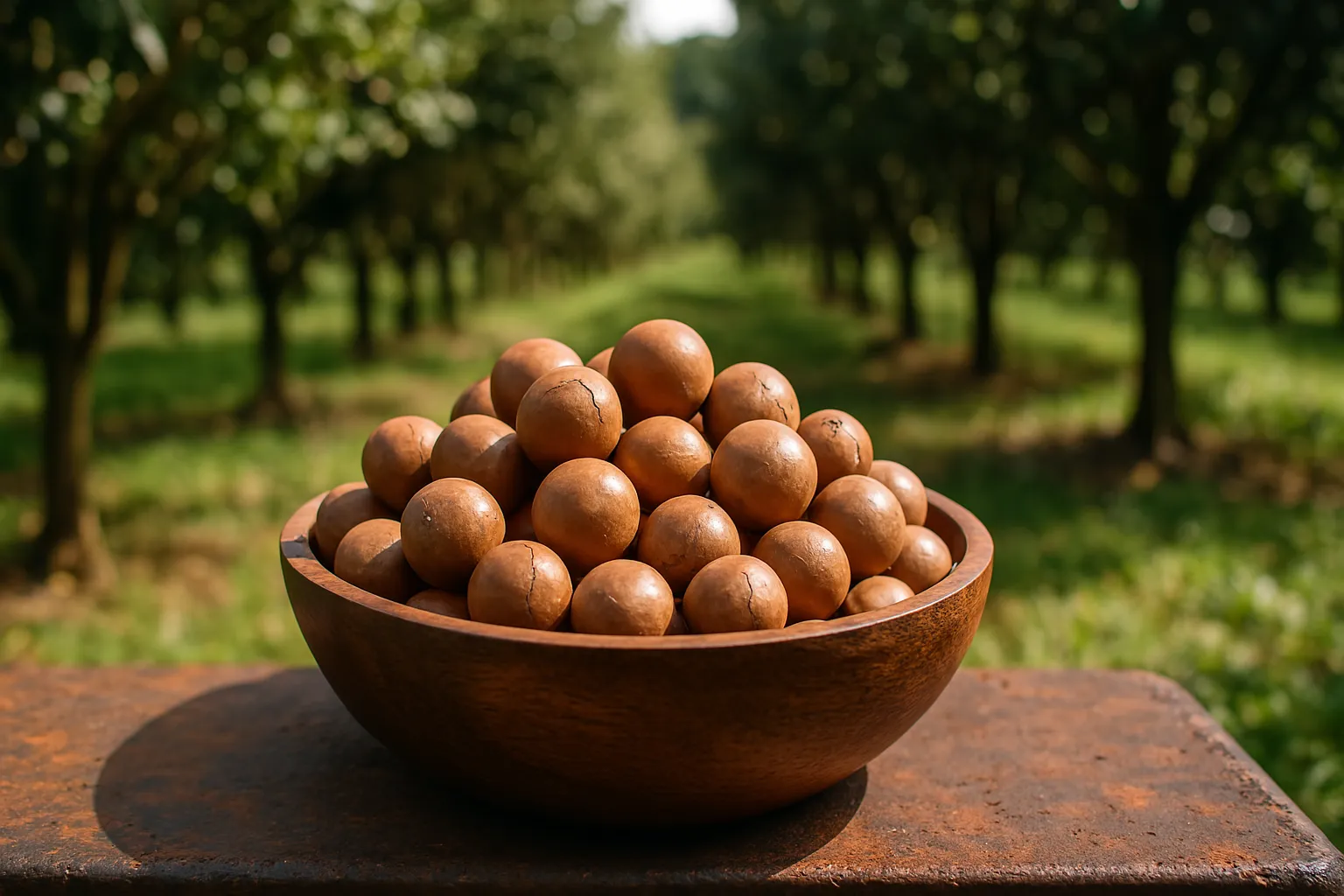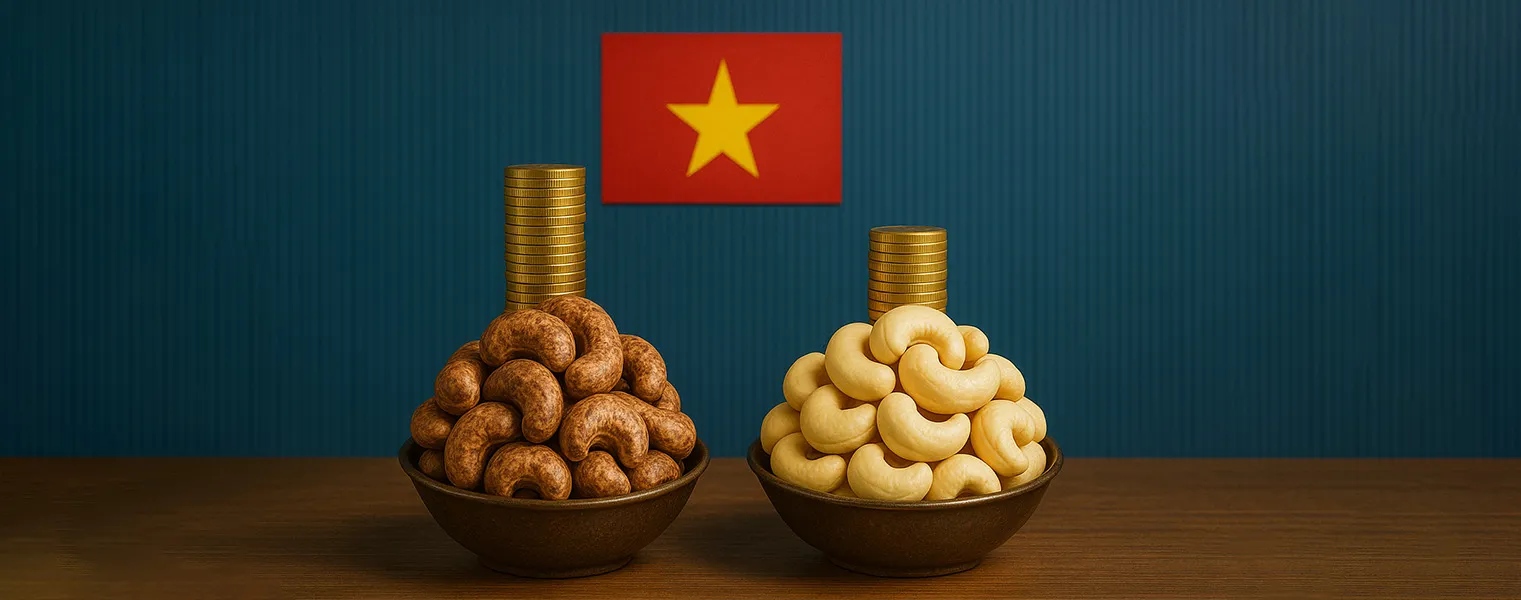Australia’s Macadamia Crop Survives Cyclone Alfred, Kenya’s In-Shell Ban Fuels Smuggling Fears: Is China Buying Up All the Premium Macadamias from Down Under?
Macadamias continue to be a premium tree nut in 2025, riding a wave of global consumer fascination with “healthy fats” and plant-based nutrition. Yet, behind the scenes, recent weather disturbances in Australia, mixed signals from global production forecasts, declining EU imports, and price-sensitive buying are shaping a complex market narrative. Below is a comprehensive market update covering the latest news, worldwide production statuses, top exporters/importers, harvest details and quality, pricing trends, future outlook, and the underlying reasons behind shifting exports. At the end, we provide a section of additional & complementary insights from the content that did not fit neatly above.

1. Latest Market Updates & News
A. Cyclone Alfred in Australia: Less Damage Than Feared
- New South Wales Hardest Hit
Cyclone Alfred battered parts of northern New South Wales on 8–9 March, causing orchard damage with high winds and heavy rainfall. While farmers in the region scramble to clean up, the Australian Macadamia Society (AMS) says the overall impact on national production remains lower than initially expected.
- Queensland Harvest Continues
The state of Queensland, which accounts for ~70% of Australia’s macadamia production, escaped the worst of the weather. Growers in Bundaberg (Queensland’s top region) report solid yields and good quality nuts. This factor helps keep Australia’s total 2025 macadamia crop on track.
- Revised Crop Estimates
The AMS had initially forecast 56,890 MT (in-shell, 3.5% moisture) for 2025. After evaluating Cyclone Alfred’s damage, the figure was trimmed slightly to 55,960 MT. The society will reassess the final tally in September.
B. EU Imports Decline Sharply
- EU Macadamia Imports
Data from 2024 vs. 2025 indicates an overall drop of -19.9% (1,542 MT down to 1,235 MT). Surprising is South Africa’s 16.9% gain to 880 MT, while some other origins plummeted:
- Kenya: -79%, from 481 MT to 102 MT
- Guatemala: soared from basically 0 to 55 MT (+5,499,900% yoy)
- Australia: down 15.7%, from 166 MT to 140 MT
- Reasons Behind Lower EU Demand
Industry insiders suggest the drop stems from economic caution in the Eurozone plus leftover supply from last year’s deals. Some big buyers remain price-sensitive, mindful of possible macroeconomic slowdowns.
C. “Upbeat” INC Estimates vs. Market Sentiment
- INC Global Forecast
The International Nut and Dried Fruit Council (INC) projects a 6% rise in 2025 global in-shell macadamia production to 344,240 MT, plus a 9% jump in kernel production from 88,220 MT to 96,180 MT. Key producers like South Africa, China, Kenya, and Guatemala are all expected to see moderate to strong expansions.
- Industry Skepticism
Observers caution that these “upbeat” top-line figures might not reflect immediate real-world constraints. For instance, Australia’s recent cyclone, Kenya’s export ban on in-shell nuts, and uncertain Chinese orchard expansions may result in lower actual deliveries to international markets.
D. Kenya’s In-Shell Export Ban Sparks Smuggling Risks
- Export Ban
Kenya reaffirmed a ban on in-shell nut exports for the new season beginning 1 March, hoping to foster local shelling. However, many Kenyan traders are suspected to re-route these in-shell nuts to China via Tanzania to circumvent the ban.
- Production Up
Flowering and fruit set were favorable in Kenya, so total output may rise by 5–8%. The question remains how much will officially enter the global kernel trade versus being lost to unrecorded cross-border shipments.
E. China’s Market Developments
- Higher Prices Weigh on Demand
Early-season transactions in China show buyer focus on style 1 kernels, but many demand lower prices due to caution over consumer spending. The result: negotiations with major in-shell suppliers in South Africa move slowly.
- Domestic Output
China’s orchard expansions continue. If weather cooperates, local production could see a further bump of 5,000–10,000 MT. With China’s increasing output, it’s unclear if domestic demand can absorb the entire volume or if competition from other origins will intensify.
F. North America’s Demand Wobbles
- Economic Downturn Fears
In the U.S. and Canada, some big retail or processing buyers are deferring large purchases, suspecting a mild recession that could weaken premium nut sales.
- Carryover Contracts
Some 2024 supply obligations remain unshipped, typically locked at lower prices. If these arrive into a market with mild demand, short-term downward price pressure could result.

2. Global Production Status
- Australia
- Crop near 56,000 MT in-shell at 3.5% moisture. Cyclone Alfred inflicted local orchard harm in New South Wales, but Queensland harvest is robust.
- South Africa
- Preliminary 2025 estimates show a 7% uptick. Positive orchard expansions, though hot weather could curb nut size.
- China
- Ongoing expansions might add 5,000–10,000 MT, strengthening domestic supply.
- Kenya
- Despite an in-shell export ban, orchard expansions put total production growth ~5–8%.
- Guatemala
- INC projects a 20% jump to ~12,000 MT, albeit from a smaller base.
- Others
- Malawi, Vietnam, and Brazil show moderate volumes. Brazil sees a forecast drop from 6,500 to 5,000 MT (-23%) per INC data.

3. Major Exporters & Importers
- Exporters:
- Australia: Typically focusing on high-quality kernel exports.
- South Africa: Emerging as a strong competitor, especially for in-shell.
- Kenya: Potentially more kernel shipments if the in-shell ban is effective.
- China: Not historically a big macadamia exporter, but orchard expansions might change that in the future.
- Importers:
- EU: Key kernel buyer, though 2025 imports are down 20% yoy.
- North America: Steady but overshadowed by potential consumer spending dips.
- China: Buys both in-shell and kernel forms, but sensitive to price hikes.
- Japan: A consistent premium kernel market, often overshadowed by overshadowed from the data.

4. Product Quality, Harvest Time & Key Considerations
- Harvest Windows
- Australia: February–August, with Queensland typically the earliest.
- South Africa: Usually from February–June, depending on region.
- Kenya: Harvest from March onward, but local orchard expansions can shift monthly supply peaks.
- Quality
- Style 1: Large, whole kernel, minimal breakage, premium price.
- Style 4, 4L, 4R/S: Smaller or partial kernels, cheaper but still in demand for processed goods.
- Moisture Content
- Most global trade references in-shell macadamias at around 3.5% moisture basis. Overly moist product risks rancidity or fungal issues.

5. Prices Now & Future Trends
A. Current Price Landscape
- South African Kernels:
- Style 1 pasteurized: ~USD 16.15/kg
- Style 4L: ~USD 12.25–12.00/kg
- Kenya:
- Style 1L ~USD 15.25/kg
- 4L ~USD 10.90/kg
- 4R/S ~USD 10.70/kg
- Guatemala:
- Style 1s around USD 15.25/kg
B. Factors Lifting or Lowering Prices
- Cyclone Alfred: Slightly less damage than feared; reduced talk of major supply disruptions from Australia.
- EU’s Sharp Import Drop: Demand caution plus leftover stock from last year reduce immediate necessity. If new contracts remain limited, some price pressure might build to remain competitive.
- Chinese Demand: Buyers demand lower prices for style 1 kernels, especially with North American uncertainties.
- Production Gains vs. Consumption: The INC’s 9% kernel production jump might outpace near-term appetite if key markets slow.
C. Market Outlook
- Short-Term: Slightly cautious. The supply is robust in top origins, but demand from the EU and North America looks subdued.
- Mid-Term: If the rumored global economic downturn intensifies, premium nuts like macadamias might see slower retail volumes. Alternatively, stable Chinese interest or renewed promotional campaigns in the EU can sustain or push prices upward.

6. Market Analysis & Signals: Export & Prices, Reasons Behind
Despite stable to abundant production, why are some producers/exporters shipping less or encountering weaker demand?
- Cautious Buyers: After a rollercoaster in global commodity markets last year, big importers only secure immediate needs, waiting for possible price dips.
- Supply Chain Disruptions: A few orchard expansions in Africa or Guatemala coincide with shipping or logistical complexities; some smaller traders face capital constraints or bankruptcies.
- Farmers Holding Stock: Eager to exploit any short supply illusions, some growers store nuts post-harvest, hoping for better terms.
- Capital & Price Doubling: With macadamias at high price points, significantly more liquidity is needed to keep trade flows normal. Some importers, especially in the EU, choose to reduce volumes to manage risk.
7. Additional & Complementary Updates & Info
After reviewing all content thoroughly, here are extra bits not fully integrated above:
- U.S. Tariff Impact on Macadamias: While the new 2025 U.S. tariffs mainly hit bigger nuts segments like almonds, pistachios, or walnuts, macadamias can be indirectly affected if trade partners retaliate or shift preferences away from American tree nuts altogether.
- New Demand in Middle East: Not widely reported, but anecdotal data suggests increased interest in premium macadamias for Ramadan and gifting. This might open new channels for South African or Kenyan in-shell nuts.
- Price-Quality Differentiation: Some high-end style 1 or 1L kernels remain in short supply, especially from top-tier suppliers. Meanwhile, lower style kernels might see oversupply if demand from bakery or confectionery slows.
- Processing Innovations: In certain orchard regions, new mechanical huskers, color sorters, and digital dryness monitors enhance product consistency, which can strengthen brand identity for those exporters.
- Longer-Term Growth: The macadamia orchard expansions in Guatemala and Vietnam might be overshadowed near-term, but come 2026–2027, these new trees could push global output significantly higher, potentially pressuring prices if demand lags.
Conclusion
The global macadamia market in 2025 navigates a confluence of robust orchard expansions, shifting demand patterns, and natural events like Cyclone Alfred. While Australia grapples with localized orchard damage, overall national yield remains mostly intact. Meanwhile, South Africa sees moderate production gains, Kenya tightens in-shell exports (prompting smuggling risk), and the INC remains bullish with a 6% yoy production hike. Yet actual sentiment among traders is more subdued, reflecting lower EU imports, uncertain demand in North America, plus Chinese buyers pressing for favorable prices.
Key Observations:
- Australia remains a top premium kernel supplier despite weather hiccups.
- South Africa capitalizes on orchard expansions but faces cost constraints.
- Kenya’s in-shell ban might ironically boost black-market shipments.
- China wants cheaper style 1 kernels, with domestic orchard expansions on the horizon.
- EU sees ~20% yoy import drop, highlighting potential oversupply or price standoffs.
In summary, near-term macadamia prices may remain stable or slightly under pressure if global economies slow or demand is cautious. However, the sector’s long-term fundamentals remain promising—provided orchard expansions align with steady consumer appetite for premium nuts.
FAQ: Global Macadamia Market 2025
- FAQ: How Much Did Cyclone Alfred Affect Australia’s Macadamia Crop?
Although northern New South Wales suffered orchard damage, the overall national impact is smaller than feared. Queensland, which accounts for about 70% of Australian macadamia output, largely escaped the cyclone’s worst effects, keeping Australia’s 2025 crop near 55,960 MT (in-shell, 3.5% moisture).
- FAQ: Why Did EU Macadamia Imports Drop Nearly 20% This Year?
Economic caution in the Eurozone and leftover stocks from the previous season have led to more conservative purchasing. As a result, the EU’s 2025 macadamia imports decreased from 1,542 MT to 1,235 MT.
- FAQ: What Are the “Upbeat Estimates” vs. Actual Market Sentiment?
The International Nut and Dried Fruit Council (INC) projects a 6% global production rise for macadamias in 2025, but real-world factors – like Cyclone Alfred, Kenya’s in-shell ban, and slower demand in the EU – have many traders more cautious than the official figures suggest.
- FAQ: How Does Kenya’s In-Shell Export Ban Affect the Global Market?
Kenya’s ban on in-shell shipments has led to concerns that some product will be smuggled via Tanzania into China. Meanwhile, Kenyan orchard expansions push production up about 5–8%, although official exports may shift toward kernels only.
- FAQ: Are Chinese Buyers Driving the Macadamia Price?
China, the world’s largest importer, is a key price influencer. This season, Chinese buyers want lower prices, especially for style 1 kernels. Still, robust orchard expansions in China could limit future import volumes if local production meets more domestic demand.
- FAQ: Why Are North American Importers Hesitating?
Fears of a mild U.S. recession and cautious retail spending dampen immediate buying. Some 2024 carryover contracts remain unshipped, possibly exerting short-term downward price pressure should they arrive amid tepid demand.
- FAQ: What Are Typical Macadamia Prices in 2025?
South Africa’s pasteurized style 1 fetches around USD 16.15/kg, while style 4 ranges from USD 12.00–12.25/kg. Kenyan style 1L stands near USD 15.25/kg, and Guatemalan style 1s around USD 15.25/kg. Freight costs, orchard yield, and demand heavily influence final quotes.
- FAQ: How Will Macadamia Prices Evolve Over the Next Few Months?
Prices may stay firm, given that Cyclone Alfred’s effects proved smaller than expected, and global orchard expansions meet uncertain demand. If the EU and North America remain cautious buyers, or if China pushes for price cuts, a mild correction could occur. Conversely, robust demand and orchard restraint might keep prices stable or rising.
- FAQ: Is There Significant Growth Outside Traditional Producers?
Yes. Countries like Guatemala are rapidly expanding production (20% yoy), while Kenya’s orchard expansions continue. China itself invests in new orchard acreage. These new suppliers could reshape the macadamia export landscape longer term.
- FAQ: What Should Buyers and Sellers Watch For This Season?
- Weather Events (like Cyclone Alfred) can drastically affect orchard yields.
- Export Bans in countries like Kenya alter supply streams, potentially spurring black-market shipments.
- Economic Factors – A potential slowdown in major markets (EU, US) might crimp demand for premium-priced nuts.
- Harvest & Quality – Confirm dryness levels and style breakdowns (style 1 vs. style 4, etc.), as end-user needs vary greatly.









